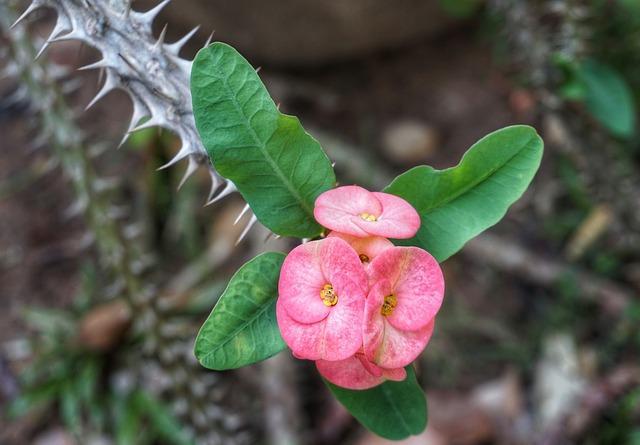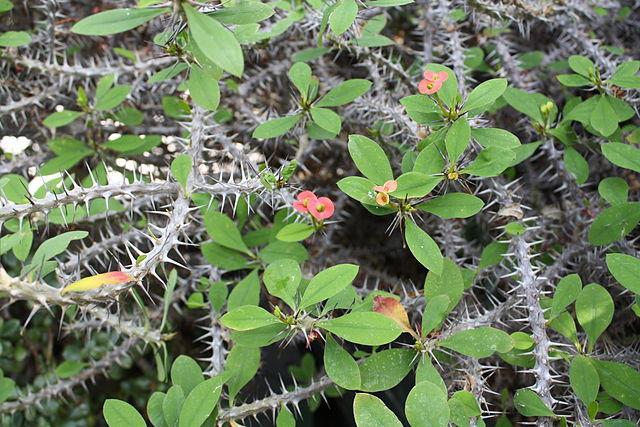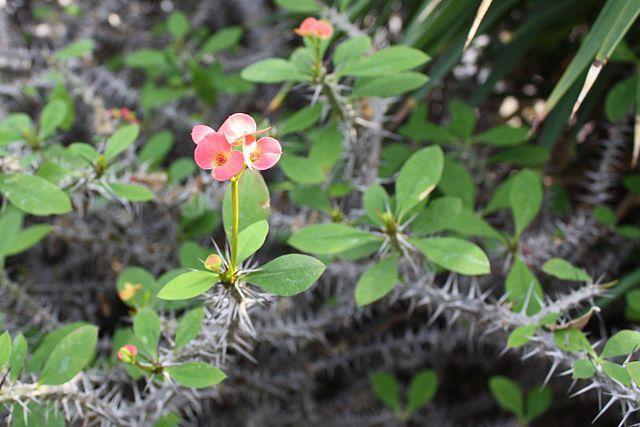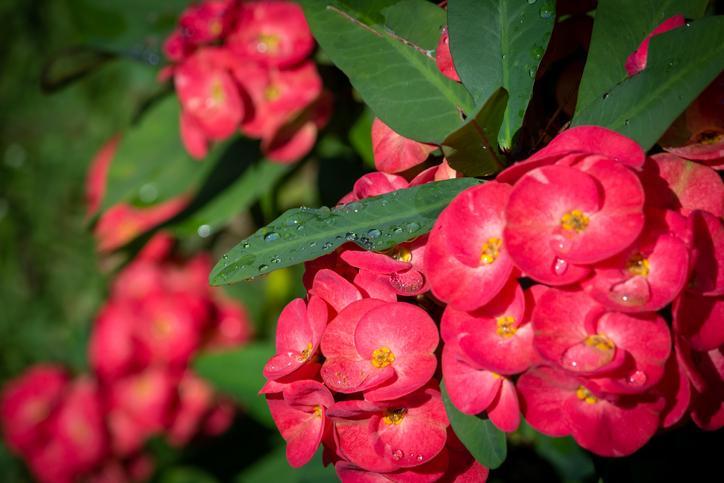Crown of Thorns Plant - How to Care for a Crown of Thorns


Euphorbia milii, popularly known as crown of thorns, Christ plant, or Christ thorn, is a species of flowering plant native to Madagascar. The species is commonly associated with the crown of thorns that Christ wore. The plant has small leaves with predominant thorns and colorful flowers. The crown of thorns is the perfect choice if you want to add some greenery to your home without too much effort. It is low maintenance, adaptable and thrives both indoors and outdoors.
In this article from thedailyECO, you will learn how to care for crowns of thorns, so it can live a long and healthy life.
Climate for the crown of thorns
Originally from a tropical environment, this plant is unable to withstand low temperatures. However, it can survive hot and dry summers. Crown of thorns should ideally be kept at temperatures between 20ºC and 35ºC (68-95 °F).
It can only be kept outdoors if you live in a tropical area, as cold winters can greatly harm or even kill the plant. It should never be exposed to temperatures below 10ºC (50 °F). When the temperatures in your area start to drop at night, it's time to bring your crown of thorns indoors for the season. Choose a spot in your home that meets the recommended conditions for growing indoors, and leave it there until the temperature starts to rise steadily again.
It should be noted that maintaining proper humidity levels is also crucial. If you live in an area with dry air, consider using a humidifier to create a more suitable environment for the plant.

Location and light for the crown of thorns
Even in hot climates, crown of thorns flowers best when placed in full sun. So if you want to enjoy the colorful flowers of this plant, find a location that is as sunny as possible. Ideally, the crown of thorns should receive full sun for three to four hours every day. If the crown of thorns receives sufficient sunlight, it can bloom year-round instead of just from late spring to early fall.
If you move your crown of thorns from an indoor location to full sun, the leaves may suffer burns. However, in a few days or weeks, the plant will get used to the new location and recover quickly. If you are keeping the plant indoors, place it in a west or south-facing spot during winter.
On the other hand, if your indoor space lacks sufficient natural light, you might consider supplementing with grow lights. These can help ensure the plant receives the necessary light for optimal blooming.

Soil for the crown of thorns
The demands of crown of thorns to the soil are not too high, because, as we have already mentioned, it is a very adaptable houseplant. Therefore, the plant does not need a particularly nutrient-rich soil, but it does need a substrate that does not retain water or moisture for too long.
If you want to plant it outdoors, do so in well-drained soil and full sun. If you plant it in a pot, prepare a mixture of peat and river sand or coconut fiber, which will improve and facilitate drainage capacity. A little vermiculite and perlite are also helpful.
Last but not least, do not plant crown of thorns in a container that is more than an inch larger than its root ball. Remember that if there is too much soil, the water will collect and the roots may rot.
Additionally, when selecting soil, consider incorporating organic matter to further enhance drainage and aeration. This will help prevent root rot and other moisture-related issues.
Watering for the crown of thorns
The crown of thorns is a very hardy species in terms of drought. It can withstand long periods without watering and is even grateful to have them once in a while. The rule of thumb is not to water until the substrate is completely dry.
If you are growing your crown of thorns in a pot, make sure the pot has drainage holes. If you place a saucer underneath, make sure that you empty it about 20 minutes after watering so that the roots do not take up water again.
In winter, this plant needs even less watering. The moisture in the soil combined with the cold can be very harmful to the plant.
For example, during periods of excessive rainfall, it's advisable to check the soil moisture regularly to ensure the plant's environment remains balanced.

Fertilizer for the crown of thorns
This plant does not need fertilizer, although a small dose, as with all plants, may encourage flowering during the blooming period. Plants need all the help they can get, especially when they are planted for the first time.
You can start by using a special fertilizer for succulents, diluted in water. The crown of thorns does not require a large amount of fertilizer. If you are unsure about the amounts, do not over do it. Keep in mind that it is better to fertilize too little than too much.
During the warmer months, half the recommended fertilizer dose can be added after the first year of the plant.
Similarly, it's beneficial to monitor the plant's response to the fertilizer. If you notice any signs of over-fertilization, such as yellowing leaves, reduce the frequency or concentration.
Pruning of the crown of thorns
The crown of thorns plant does not need pruning, but if you want to control its growth and shape, it is best to do it in the summer. Most crowns of thorns do not need to be pruned until the second or third year, if ever, because of their slow growth.
To prune the crown of Christ, as with any plant, you need to sterilize the tools you use and cut off the excess growth.
The best time to prune this plant is after summer. Cut back each pruned branch to an axillary branch. This will provide stronger branching and a healthier, more productive flowering of your plant.
Wear thick gloves and goggles to protect yourself from the milky sap of the crown of thorns, which is irritating and can cause dermatitis and temporary blindness. Note that the thorns of this plant are thick and woody, so they can easily pierce most gardening gloves.
In this regard, always dispose of the pruned branches carefully to avoid injury or irritation to others.
How to propagate the crown of thorns
Crown of thorns is easily propagated by cuttings. To increase the chances of success, it is recommended to water the plants a day or two before taking cuttings to ensure that the cuttings have enough water in their stems. Then, follow the instructions below:
- Cut off the top 3-4 inches of a healthy young stem. It is best to do this during the growing season, that is, the part of the year when humidity and temperature allow the growth of plants, usually from late spring to early fall.
- Spray the cut end with cool water to stop the sap from flowing.
- Store on absorbent paper for 3 days for the cut to dry completely.
- Remove most of the leaves on the cuttings, leaving on 3 or 4.
- Then moisten the cut surface (if you use tea, all the better) and plant the cuttings in small seedlings or pots.
- Place the cuttings in a warm, well-lit place, but without direct sunlight.
- Keep the substrate slightly moist for the first few weeks until the cutting has taken root. Once you see new growth, you can place it in its final location, either in a large pot or in the ground.
It's important to monitor the humidity levels around the cuttings, as too much moisture can lead to rot. A fine misting occasionally can help maintain the right balance.

Why is my crown of thorns not blooming?
If your crown of thorns plant is not blooming, it could be because it is not getting enough light, or it's too cold. Move your plant to a warmer, better-lit location and avoid proximity to air conditioners, heaters, or other artificial heat sources.
You may also have fertilized it too much or used the wrong fertilizer, which can result in late blooming or no blooming at all.
Finally, an outdoor crown-of-thorns plant can tolerate some rain, but too much moisture can lead to fungal diseases that can also affect flowering.
In addition, pests such as aphids or spider mites can also impact blooming. Regularly inspect your plant for signs of infestation and treat promptly to ensure healthy growth.
You can learn more about crown of thorns plants in the video below, as well as some other tips for taking care of them.

If you want to read similar articles to Crown of Thorns Plant - How to Care for a Crown of Thorns, we recommend you visit our Plant care and cultivation category.









